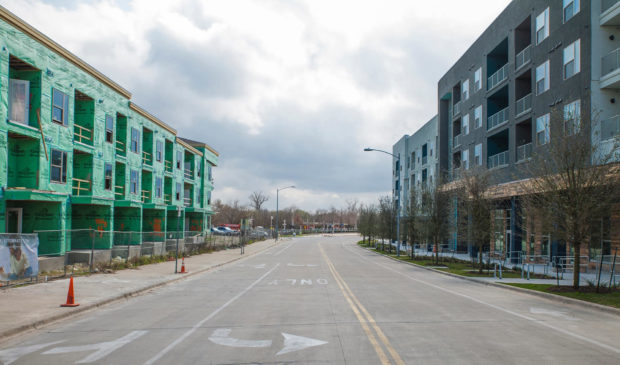Rents rise despite new housing keeping pace with growth, study finds
Tuesday, October 10, 2017 by
Audrey McGlinchy, KUT Developers that want to build low-income housing in wealthier neighborhoods should engage more with neighborhood groups to convince them of the merits of affordable housing.
That’s one recommendation in a study published today by the Urban Institute, a nonpartisan think tank.
The study assessed the state of low- and middle-income housing in Austin with input from local developers, community representatives and affordable housing experts. One of the nation’s largest mortgage lenders, JPMorgan Chase & Co., funded the study, along with similar studies of Miami and Denver.
“What we found in Austin is that there’s this new influx of sort of younger and more affluent people coming into the city,” said Diana Elliott, the study’s lead researcher.
According to recent census estimates, 29 percent of Austin’s newest households are made up of white people under the age of 30. The number of East Coast transplants has increased, from 20 percent to 28 percent.
And building has kept pace with the city’s population increase.
Between 2000 and 2015, Austin’s population grew by 20 percent. The addition of new housing units kept relative pace with this growth, as builders added more than 69,000 units, a 19 percent increase since 2000. Despite this, the percentage of renters who spent 30 percent or more of their income on housing grew from 41 percent to 48 percent.
While the Urban Institute study does not consider the types of housing being built, Elliott said she heard from local developers that Austin is building too many studio and one-bedroom units.
“Obviously, if you have a working family, that’s not going to work for them,” she said. “A studio is not going to be what they need.”
City demographer Ryan Robinson estimates that of 10,000 new housing units built in 2016, roughly 65 percent were one-bedrooms or studios.
Elliott also said that Austin stood out for its high rate of neighborhood involvement in housing decisions – which can have both positive and negative impacts on affordability.
“It’s good because neighbors are engaged, they’re thinking about their community,” she said. “But it tends to be an issue for affordable housing development when neighbors can block affordable housing from coming into their neighborhood.”
At the end of its study, the Urban Institute offers some recommendations on how Austin can pay for and encourage the building of more affordable housing – including lobbying for homestead preservation districts, which allow the city to collect taxes on new development in a specific neighborhood and spend it on repairing or building affordable housing in that area.
Austin currently has one functioning homestead preservation district, but it has since outgrown the state criteria allowing cities to create these districts.
“This is a really unique and great policy that Austin has that perhaps just needs, in the next couple of years, more evidence and more support to make the case for expansion,” Elliott said.
This story has been corrected. We originally reported that the percentage of income renters spent on housing grew – from 41 percent to 48 percent when, in fact, the percentage of renters who spent 30 percent or more of their income on housing grew from 41 percent to 48 percent.
This story was produced as part of the Austin Monitor’s reporting partnership with KUT. Photo by Pavel Mezihorak for KUT.
The Austin Monitor’s work is made possible by donations from the community. Though our reporting covers donors from time to time, we are careful to keep business and editorial efforts separate while maintaining transparency. A complete list of donors is available here, and our code of ethics is explained here.
You're a community leader
And we’re honored you look to us for serious, in-depth news. You know a strong community needs local and dedicated watchdog reporting. We’re here for you and that won’t change. Now will you take the powerful next step and support our nonprofit news organization?






